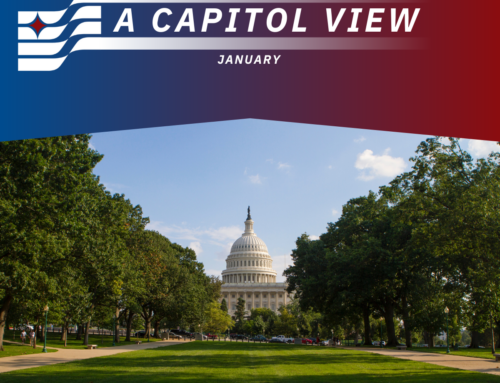Greetings! We hope you are doing well.
We had planned to wish you a Happy New Year with this note. However, 2021 has certainly started with troubling events here in the nation’s capital. Last week was historic for many reasons, not the least of which included the election outcomes in Georgia. However, for those of us who live in Washington and have visited and worked in the U.S. Capitol complex, January 6th was a frightening and sickening day.
Thankfully, our Republic still stands (words we never thought we would type)! Our thoughts are with the law enforcement officers who sacrificed much defending the U.S. Capitol last Wednesday. We are deeply saddened by the loss of life, destruction, and threat to Congress caused by deplorable insurrectionists. The United States faces challenging weeks and months ahead.
However, we remain hopeful. With new leadership in the White House and Congress, we look forward to improved efforts to overcome the COVID-19 pandemic, increased investments against climate change, and the hard work to rebuild bipartisan ties across a divided nation. We will certainly do our part!
While it seems inappropriate to discuss good news right now, it is worth celebrating the excellent work by the House of Representatives and Senate at the conclusion of the 116th Congress in December. In addition to funding the federal government for the remainder of the fiscal year, the Consolidated Appropriations Act – 2021 (H.R. 133) also included several important provisions related to the U.S. Department of Energy and the U.S. Navy which will be helpful to the domestic water power sector and the clean energy industry as a whole. We have provided a quick update below along with some other news.
Finally, we want to give a shout out to the Verdant Power team for the successful deployment last fall of their fifth-generation turbines in New York City’s East River. The project is producing enough electricity to power 500 apartments in Manhattan. This is a key demonstration of what marine energy can contribute to the nation in the near future. Learn more about the deployment here and here. Great job, Verdant!!!
Back in touch soon. In the meantime, take care, be safe, and love your neighbor. We all need it right now!
The SMI Water Power Team
Water Power R&D Legislation Becomes Law After Eleven Year Effort!
First, we are very pleased to report that H.R. 133 contained a final version of the Water Power Research and Development Act drafted by Rep. Suzanne Bonamici and Senator Ron Wyden, both of Oregon. The Water Power R&D bill is now the law of the land after eleven years of lobbying! We offer our special thanks to both Rep. Bonamici and Senator Wyden for the years of effort it took to finally bring this measure across the finish line. We also want to say thanks to the cosponsors of the original House Water Power R&D bill (H.R. 6084), including Rep. Eddie Bernice Johnson (Texas) – Chair of the House Science Committee, along with Rep. Ted Deutch (Florida), Rep. Don Young (Alaska), and Rep. David McKinley (West Virginia). We also thank Senator Mazie Hirono (Hawaii), Senator Patty Murray (Washington), Senator Jack Reed (Rhode Island), Senator Angus King (Maine), Senator Jeff Merkley (Oregon), and Senator Brian Schatz (Hawaii), for their co-sponsorship of Senator Wyden’s Marine Energy R&D bill (S. 1821). Finally, Senator Murkowski reached her term limit as chair of the Senate Energy and Natural Resources Committee at the conclusion of the 116th Congress. The Water Power bill would not be law without her support over the past decade.
The Water Power R&D legislation provides long-term policy and research direction to the DOE Water Power Technologies Office (WPTO). It authorizes $137 million per year for marine energy and $49 million per year for hydropower/pumped storage over Fiscal Years 2021-2025. The legislative text can be found on page 3358 here. Of note, Congress has now revised the sector’s federally recognized name from “Marine and Hydrokinetic Renewable Energy” (or MHK), to simply “Marine Energy.” The updated definition of Marine Energy covers “energy from waves, tides, and currents in oceans, estuaries, and tidal areas; free flowing water in rivers, lakes, streams, and man-made channels; differentials in salinity and pressure gradients; and, differentials in water temperature, including ocean thermal energy conversion.” Finally, the term “Water Power” refers to marine energy and hydropower (which includes conduit power and pumped storage).
SMI’s Paul Gay and Jeff Leahey worked for over a decade to achieve passage of the water power legislation. However, this success would not have happened without the help and support of so many NHA/MEC members (and SMI clients!), along with a cadre of dedicated congressional staff, over the past eleven years. We are forever grateful. In addition, the $137 million funding level gives us something to work towards in Fiscal Year 2022 and beyond.
Fiscal Year 2021 Appropriations – Funding for Water Power
Speaking of funding, H.R.133 also brought to closure the FY 2021 appropriations process. We are pleased to report that the DOE WPTO is getting a record $150 million! Thank you to our Congressional champions along with their staff who worked to increase funding for the Water Power sector. In 2020 we had support from 45 Members of Congress from across the country for Rep. Bonamici’s water power funding letter to the House Appropriations Committee. These Members were crucial to our success as they listened to the Marine Energy Council on industry needs and supported historic funding levels.
We expect several R&D Funding Opportunity Announcements to be released by the DOE WPTO over the next few months. Please let us know if you need information or help on developing winning solutions for securing federal R&D support.
Below is the final language and funding direction given to DOE by Congress for the balance of this fiscal year:
“Water Power – The agreement provides $109,000,000 for Marine and Hydrokinetic Technologies and not less than $41,000,000 for Hydropower Technologies. The agreement supports research and development, testing, and partnership activities for the Powering the Blue Economy Initiative and provides not less than $24,000,000 for these activities. The Department is directed to use existing core capabilities within its national laboratories to execute this work, in partnership with universities and industry. The Department is encouraged to use existing authorities to waive cost share for small businesses and maximize competitively awarded solicitations for industry-led research and development initiatives and project deployment. The Committee recognizes the challenges of decarbonizing remote communities and the maritime sector. The Department is encouraged to focus on activities addressing the integration of clean energy systems for remote communities and port electrification, including the demonstration of marine, distributed wind, solar, energy storage, improved microgrids, and local production of zero-carbon fuels. Within funding for marine and hydrokinetic technologies, $60,000,000 is for a balanced portfolio of competitive solicitations to support industry- and university-led research, development, demonstrations and commercialization of wave and current (ocean, river, tidal) systems and component technologies to increase energy capture, reliability, survivability, and integration into local or regional grids for lower costs and to assess and monitor environmental effects. The Department is encouraged to consider the need to create a pipeline of well-trained students when determining competitive solicitations. The agreement recommends not more than $10,000,000 is for the Testing Expertise and Access for Marine Energy Research Program and related infrastructure investments. Within available funds, up to 10,000,000 is provided to address infrastructure needs at marine energy technology testing sites. The Department is directed to continue its coordination with the U.S. Navy on marine energy technology development for national security applications at the Wave Energy Test Site and other locations. The agreement provides up to $5,000,000 to continue operations at the Atlantic Marine Energy Center”.
The agreement provides not less than $15,000,000 for hydropower and pumped storage modernization initiatives, including technologies, models, and analytical capabilities to support integration of intermittent generation, increase grid resilience and reliability, and improve access to electricity in remote communities or those with inadequate service. Within available funds, $3,000,000 is provided to identify opportunities for improvements in hydropower infrastructure, operations, and methods of deployment to provide benefits to other managed water systems, such as irrigation and municipal water supply. Within available funds, the agreement provides $5,000,000 for small hydropower technology innovation, testing, and initiatives. The agreement also recommends funding for new data collection and analysis to improve operations and maintenance by better understanding the impacts of changing operations on equipment failure rates, reduced availability and costs, including long-term and short-term inflow modeling work. Within available funds, $1,500,000 is provided to accelerate development and demonstration of environmental mitigation technologies to address dissolved oxygen, water quality and fish passage, including for invasive species management. Within available funds, $5,000,000 is provided for the environmental analyses and engineering of potential run-of-river hydrokinetic facilities at two sites with high electricity costs and diesel use, as determined by the Department. Funding may be used for such related field work, engineering, and analysis necessary for a future Federal Energy Regulatory Commission License. The Department is encouraged to continue science and modeling efforts to advance hydroelectric turbine design to increase energy production while reducing environmental impacts, including field data collection and improvements to fish tagging technology.”
U.S. Navy Funding
We also successfully lobbied to secure $25.5 million for the Navy Energy Program with $10.5 million specifically for a Marine Energy Systems for Sensors and Microgrids program. There is also $25 million provided for “Alternative Energy” programs to be funded by the Office of Naval Research. The below FY 2021 report language provides guidance to the Navy for allocating these funds:
Navy Alternative Energy Research – “The Committee recognizes the need for additional research by the Navy in its efforts to create a more robust energy infrastructure, to reduce the cost of energy, and to increase energy security, reliability, and resiliency at Department of the Navy facilities and on naval platforms. A broader range of experimentation, prototyping, and development is necessary for future naval capabilities related to powering maritime systems, at-sea persistent surveillance and communications systems, and unmanned undersea vehicle charging. The Committee encourages the Secretary of the Navy to partner with universities, affiliated research facilities, and other federal agencies to conduct research on electrical power intermittency, integrating renewable energy sources into the grid, energy storage, improved micro-grids, local generation of zero-carbon fuels, marine hydrokinetic energy converters for autonomous systems, tactical energy solutions, and the inspection and structural health monitoring of critical energy infrastructure.”
New DOE Awards – $22 Million for Marine Energy Foundational R&D and Testing Infrastructure
The DOE WPTO recently announced ten project selections totaling up to $22 million to support marine energy R&D and testing infrastructure. Seven of the projects selected will leverage the expertise and intellectual capital of non-federal research institutions, like universities, by supporting foundational R&D to complement efforts at the DOE National Labs. The announcement can be found here. Congrats to the winners!
NHA Reaches Out to President-Elect Biden’s DOE Transition Team
NHA leadership has initiated outreach efforts to the incoming Biden Administration and a final version of the NHA priorities letter to the transition team can be found here. NHA has now met with DOE transition team representatives and provided specific recommendations which can be reviewed here (Energy memo), along with a copy of the MEC Marine Energy Commercialization Action Plan which can be found here.
New DOE Energy Storage Grand Challenge Strategy Released
The first comprehensive DOE energy storage strategy was recently released. The Energy Storage Grand Challenge (ESGC) seeks to create and sustain American leadership in energy storage. In addition to concerted research efforts, the roadmap’s approach includes accelerating the transition of technologies from the lab to the marketplace, focusing on ways to competitively manufacture technologies at scale in the United States, and ensuring secure supply chains to enable domestic manufacturing. The roadmap includes an aggressive but achievable goal: to develop and domestically manufacture energy storage technologies that can meet all U.S. market demands by 2030. WPTO Director Alejandro Moreno was a key author of the report’s policy and valuation track.
WPTO Funding Opportunities
The deadline to submit applications for ETIPP technical assistance is February 15, 2021
The deadline to compete in the first phase of the Ocean Observing Prize’s DEVELOP Competition and DESIGN Contest is February 16, 2021 at 5 p.m. ET
The deadline to submit Phase I Release 2 SBIR full applications is February 22, 2021
The WPTO Year in Review
The DOE WPTO has released its 2020 Year-End Wrap Up.
Interesting Articles on the Incoming Biden Administration and Support for Clean Energy
Potential $40B DOE loan funding available for clean energy
Pentagon can help Biden make America greener
New Economic Stimulus Provisions
The National Conference of State Legislatures has a great summary of the latest COVID-19 Economic Relief Bill here.




